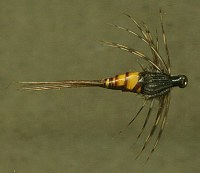Invicta Flies - Heptagenia
This nymph is tied to imitate the flatheaded mayflies. Change the color of the biot body to match your local species.
 |
 |
Hook: Mustad 3906B, #18-16
Thread: Danville's Prewaxed 6/0 black
Tail: short fibers from base of ringneck pheasant tail
Body Foundation: fine lead wire lashed to both sides of hook
Abdomen: brown goose biot
Wingcase: section of fibers from ringneck pheasant tail
Legs: hungarian partridge
Thorax: mole dubbing with guard hairs, dyed cocoa brown
Tying Instructions:
1.) Place hook in vise and secure thread to shank. Cover entire length with a layer of thread wraps.
2.) Trim two pieces of lead wire, each 3/4 hook shank in length. Cut the ends at an angle to form a taper. Tie in the far side first: lay lead wire against shank, centered and take three turns of thread around the wire and the hook shank. Pull thread toward you while holding the lead wire on a horizontal plane with the shank. This crimps the lead a little and keeps it tight. Repeat until entire length of lead wire is secured. Do the same for the other piece of lead wire on the near side of the hook. When finished, you should have a wide, flat base for the body, which tapers toward the bend of the hook.
3.) Wind thread to bend. Tie in a tail of the short fibers found at the base of a ringneck pheasant tail. About a half dozen should do it. To splay the tail fibers, simply apply more thread torque to the initial thread wrap.
4.) Tie in goose biot by its tip so the butt end curves out toward you. Wind thread to half way up the shank.
5.) Pull goose biot straight up, then over the hook. Continue wrapping forward to thread. Tie off and clip excess.
6.) Tie in a section of ringneck pheasant tail fibers equal to the hook gap in width, on top of the hook, shiny or dark side up and excess extending toward bend of hook.
7.) Collect a partridge feather of dark shade whose fibers range from 3/4 to a full hook shank in length. Stroke the fibers back and tie in by the tip so the feather curves upward and is leaning to rear of hook with wingcase.
8.) Tightly dub a thorax of mole or similar dubbing, taking care not to cover up the wide, flat profile. End thorax a hook eye's length behind eye.
9.) Pull partridge feather forward over dubbed thorax. Stroke the fibers from the thread to rear of thorax back toward the bend. Tie down the feather in the "part" created with three tight turns of thread. Clip excess.
10.) Pull wingcase forward over partridge feather and tie down. Clip excess and cover any visible butts with wraps of thread.
11.) Form a substantial head with thread, as this is a flathead mayfly nymph, whip finish, cement the head and the wingcase. You may also cement the biot abdomen for durability.